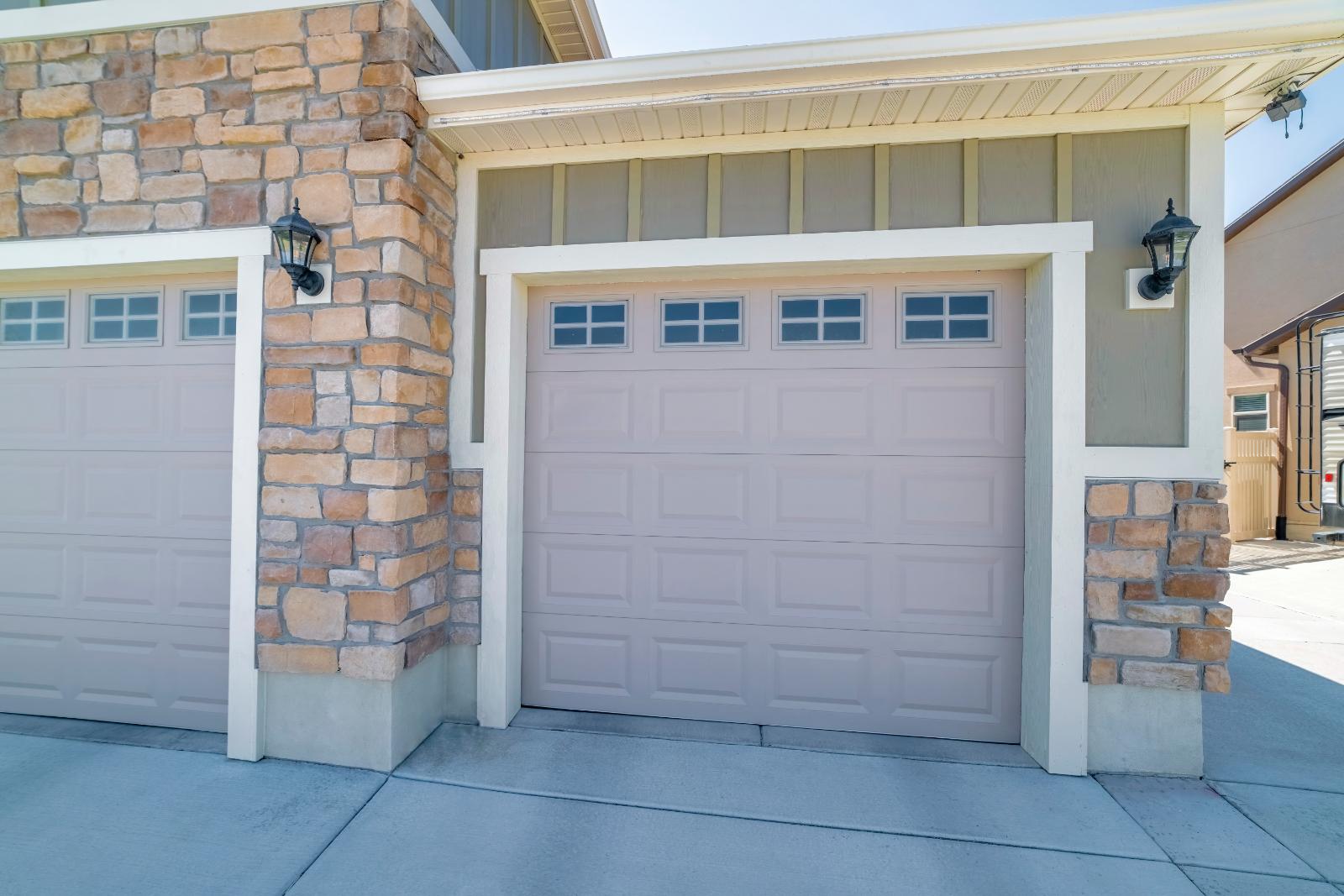Contents
When optimizing your garage doors for energy efficiency, consider them the gatekeepers of warmth and savings in your home. From selecting insulated doors to embracing the latest in smart technology, these top 10 tips can transform your garage into a beacon of efficiency. By incorporating these strategies, you’ll not only be cutting down on energy costs but also taking a step towards a more environmentally friendly and cost-effective living space.
Key Takeaways
- Insulate garage doors for better temperature control and energy savings.
- Use energy-efficient materials like recycled steel or wood composite.
- Seal gaps and cracks to prevent heat loss and improve insulation.
- Install durable weatherstripping materials like vinyl or rubber.
- Consider upgrading to energy-efficient garage door openers for reduced power consumption.
Choose Insulated Garage Doors
Consider selecting insulated garage doors to improve energy efficiency in your home. Insulated garage doors provide better temperature regulation, reducing heat loss in the winter and heat gain in the summer. This creates a more comfortable environment in your garage and helps maintain a consistent temperature in adjacent rooms, ultimately leading to energy savings.
Insulated garage doors work similarly to insulated windows, preventing the transfer of heat through the material. By keeping the cold air out during the winter and the hot air out during the summer, insulated garage doors contribute greatly to energy efficiency. In addition, when paired with other energy-saving measures like energy-efficient lighting, the impact is even more pronounced.
Energy-saving lighting not only helps reduce electricity consumption but also plays a role in overall energy efficiency. By combining insulated garage doors with energy-saving lighting, you can create a more environmentally friendly and cost-effective space. LED bulbs, for example, are a great choice for garage lighting as they consume less energy and have a longer lifespan compared to traditional incandescent bulbs.
Consider Energy-Efficient Materials
Opt for garage doors made from energy-efficient materials to enhance the eco-friendly and cost-effective features of your home. When choosing energy-efficient materials for your garage door, you not only contribute positively to the environment but also save on energy costs in the long run.
Here’s why you should consider energy-efficient materials:
Energy Efficient Design: Garage doors with energy-efficient designs help to minimize heat transfer between the inside and outside of your home. This means that during hot summers or cold winters, your garage will maintain a more stable temperature, reducing the load on your heating and cooling systems.
Eco-friendly Materials: Opting for garage doors made from eco-friendly materials such as recycled steel, wood composite, or aluminum reduces the environmental impact and ensures durability and longevity. Eco-friendly materials are often of higher quality and require less maintenance, saving you money in the long term.
Increased Insulation: Energy-efficient materials often come with enhanced insulation properties, which help regulate the temperature inside your garage. This insulation can also extend to your home, reducing energy consumption and making your living spaces more comfortable throughout the year.
Opt for Proper Installation Techniques
Proper installation techniques are essential to ensuring the highest energy efficiency and functionality of your energy-efficient garage door. They play a significant role in maximizing energy savings and ensuring the long-term benefits of your garage door investment.
When installing your energy-efficient garage door, pay close attention to the installation techniques used by the professionals. Improper installation techniques can lead to air leaks, reducing the effectiveness of proper insulation and resulting in higher energy consumption.
By focusing on correct installation methods, you can prevent these issues and enhance the energy-saving potential of your garage door. The right installation techniques contribute to energy savings and improve your garage door’s overall performance.
A well-installed, energy-efficient garage door can provide better temperature regulation within your garage, leading to reduced energy usage over time.
Invest in Professional Insulation
For top energy efficiency and insulation performance, investing in professional insulation for your garage door is essential. Professional insulation offers numerous benefits that go beyond just keeping your garage space at a comfortable temperature. Here’s why you should consider this upgrade:
Improved Thermal Efficiency: Professional insulation helps regulate the temperature inside your garage, keeping it warmer in the winter and cooler in the summer. This means you won’t have to rely as heavily on your HVAC system to adjust the temperature, leading to potential energy savings.
Enhanced Soundproofing: Insulating your garage door professionally can also help reduce noise from the outside, creating a quieter environment inside your home. This is especially beneficial if you use your garage as a workshop or living space.
Long-Term Cost Savings: While the initial investment in professional insulation may seem significant, the long-term cost savings are substantial. By reducing the strain on your heating and cooling systems, you can lower your energy bills over time, making it a cost-effective choice in the long run.
Investing in professional insulation not only improves the comfort of your garage space but also contributes to significant cost savings in the future. It’s a practical choice that enhances your home’s energy efficiency while providing a more comfortable environment for you and your family.
Seal Gaps and Cracks
Addressing gaps and cracks in your garage door is vital for maximizing energy efficiency and maintaining a well-insulated space. Weatherproofing methods play an important role in preventing heat loss during colder months and keeping the cool air in during warmer seasons. By sealing these gaps and cracks, you can greatly reduce energy waste and save on heating and cooling costs.
To effectively seal gaps and cracks, start by inspecting the perimeter of your garage door for any openings where air might leak. Common areas to check include the edges of the door, between panels, and around the frame. Weatherproofing solutions like weatherstripping, rubber seals, and foam insulation can be used to fill in these gaps and create a tight seal.
Energy-saving solutions such as applying caulk to seal small cracks or using expanding foam for larger gaps can make a noticeable difference in your garage’s energy efficiency. Additionally, installing a bottom seal on your garage door can prevent drafts and improve insulation.
These simple weatherproofing methods help conserve energy and contribute to a more comfortable and environmentally friendly home. By taking the time to address gaps and cracks in your garage door, you can enjoy a more energy-efficient space while reducing your carbon footprint.
Maintain Weatherstripping
To guarantee excellent energy efficiency in your garage, it’s essential to check your weatherstripping regularly for any signs of wear and tear. Replace any worn weatherstripping promptly to maintain a tight seal around your garage door.
Using durable materials for your weatherstripping will help prolong its lifespan and effectiveness in preventing energy loss.
Check Weatherstripping Regularly
Regularly checking and maintaining the weatherstripping on your garage doors is crucial for maximizing energy efficiency and preventing drafts. Properly installed weatherstripping offers a range of benefits, including reducing energy loss, keeping out pests, and minimizing outside noise.
To guarantee your weatherstripping remains effective, follow these DIY tips:
Inspect Regularly: Check the condition of the weatherstripping at least twice a year, paying close attention to any signs of wear or damage.
Clean Thoroughly: Keep the weatherstripping clean from dirt and debris to maintain its seal and prolong its lifespan.
Reapply Sealant: If you notice gaps or areas where the weatherstripping is no longer sealing properly, apply a fresh sealant to reinforce the insulation.
Replace Worn Weatherstripping
Check the weatherstripping on your garage doors for signs of wear and deterioration to ensure peak energy efficiency and insulation. Weatherstripping plays an important role in maintaining the internal temperature of your garage, preventing energy loss, and keeping out unwanted pests and debris. Over time, weatherstripping can deteriorate due to exposure to weather elements, leading to decreased effectiveness. By regularly inspecting and replacing worn weatherstripping, you can guarantee that your garage remains energy-efficient and well-insulated.
When replacing weatherstripping, consider the longevity of the material. Different types of weatherstripping materials have varying lifespans, so choose one that offers durability and long-lasting performance. Additionally, familiarize yourself with proper weatherstripping installation techniques to maximize its efficiency. Ensuring a proper fit and seal is important for top energy efficiency and insulation in your garage.
| Weatherstripping Material | Longevity | Installation Techniques |
|---|---|---|
| Vinyl | 10-15 years | Clean surface before applying |
| Rubber | 5-10 years | Measure and cut precisely |
| Silicone | 5-8 years | Apply adhesive evenly |
Use Durable Materials
Inspecting the condition of your garage door weatherstripping and opting for durable materials are key steps in maintaining energy efficiency and insulation. By choosing durable materials for your garage door, you can have a profound impact on your energy savings and the overall effectiveness of your insulation.
Here are some reasons why investing in durable materials is essential:
Longevity: Durable materials like vinyl or rubber weatherstripping can last for years without deteriorating, ensuring consistent insulation and energy efficiency.
Resilience: These materials can withstand harsh weather conditions, maintaining their effectiveness in sealing your garage door and preventing energy loss.
Cost-Effective: While durable materials may have a slightly higher upfront cost, their longevity, and energy-saving benefits make them a cost-effective choice in the long run.
When you prioritize durable materials for your garage door weatherstripping, you not only enhance energy efficiency but also contribute to a more environmentally friendly and cost-efficient home environment.
Upgrade to Energy-Efficient Openers
Consider upgrading to energy-efficient garage door openers, which can help reduce your overall energy consumption and costs while enhancing the functionality of your garage. Environmentally-friendly openers are designed to consume less power while operating your garage door effectively. By making this upgrade, you contribute to a more eco-conscious environment and save money on your energy bills over time.
To guide you in selecting the right energy-efficient garage door opener, take a look at the comparison table below:
| Features | Energy-Efficient Opener | Traditional Opener |
|---|---|---|
| Energy Consumption | Low | High |
| Smart Automation | Yes | No |
| Noise Level | Quiet | Loud |
Energy-efficient openers often come with smart automation capabilities, allowing you to control your garage door remotely from your smartphone. This feature provides convenience and peace of mind, knowing you can monitor and operate your garage door from anywhere.
Investing in an energy-efficient garage door opener aligns with your goals of reducing energy consumption and enhancing the overall functionality of your garage. Make the switch today to experience the benefits firsthand.
Utilize Smart Technology Features
To maximize your garage door’s functionality, explore the smart technology features available to enhance convenience and efficiency. By integrating smart technology compatibility into your garage door system, you can achieve significant energy savings and streamline your daily routines.
Consider the following benefits of incorporating smart features:
Smart Technology Compatibility: Upgrade your garage door opener to a model that’s compatible with smart home systems like Google Home or Amazon Alexa. This integration allows you to control your garage door remotely, giving you the flexibility to monitor and manage its status from anywhere.
Remote Access: With smart technology, you can open and close your garage door using your smartphone. This feature enhances convenience and enables you to grant access to delivery personnel or guests when you’re not at home, promoting a sense of security.
Energy Monitoring: Take advantage of energy monitoring capabilities offered by smart garage door systems. These features provide insights into your energy usage patterns, helping you identify opportunities to improve energy efficiency and reduce costs over time.
Incorporating smart technology features into your garage door offers convenience and contributes to energy efficiency, aligning with your goals of creating a more eco-friendly and connected home environment.
Enhance Garage Door Insulation
Improving your garage door insulation can lead to increased energy efficiency and cost savings for your home. Proper insulation helps in heat retention, ensuring that your garage stays at a consistent temperature, especially in extreme weather conditions. This means that during the hot summer months, less heat will seep into your garage, and during the cold winter months, less heat will escape, ultimately reducing the strain on your heating and cooling systems.
Enhancing your garage door insulation can greatly improve energy savings. According to the U.S. Department of Energy, insulating your garage door can help maintain a more stable temperature inside your garage, reducing the need for constant heating or cooling. This can translate into lower energy bills over time, making your home more energy-efficient and cost-effective.
To achieve ideal insulation, consider using foam board insulation, reflective barriers, or weather stripping to seal any gaps around the garage door. These simple yet effective solutions can make a substantial difference in the energy efficiency of your garage.
Schedule Regular Maintenance
To guarantee your garage door operates efficiently, regular maintenance is vital. Professional inspections are recommended to catch potential issues early on.
Additionally, there are simple DIY maintenance tasks you can perform to keep your garage door in top condition.
Importance of Upkeep
Regular maintenance schedules are crucial for guaranteeing garage doors’ energy efficiency. By staying proactive and conducting regular upkeep, you can ensure your garage door operates at its best, saving you energy and money in the long run.
Here are some key points to ponder:
DIY Weatherstripping: Proper weatherstripping helps seal gaps around your garage door, preventing air leaks that can result in energy loss. Check and replace weatherstripping as needed to maintain efficiency.
Seasonal Upkeep: Different seasons can impact your garage door’s performance. Adjusting the garage door’s sensitivity to temperature changes, lubricating moving parts, and cleaning the tracks are essential tasks for seasonal maintenance.
Monitor Wear and Tear: Regularly inspecting your garage door for signs of wear and tear, such as frayed cables or damaged weather seals, can help you address issues promptly, preventing energy loss and costly repairs down the line.
Professional Inspections Recommended
Consider scheduling regular professional inspections for your garage door to ensure peak energy efficiency and performance. Professional inspections can help identify any issues early on, preventing costly repairs down the line and ensuring your garage door operates smoothly. Additionally, professionals can assess the weatherstripping, a crucial component for energy efficiency, and provide recommendations for upkeep.
| Benefits of Professional Inspections | Frequency |
|---|---|
| Early issue detection | Annually |
| Prevent costly repairs | Bi-annually |
| Ensure smooth operation | Quarterly |
| Weatherstripping assessment | Bi-annually |
| Energy efficiency recommendations | Annually |
Regular professional inspections complement DIY maintenance efforts and help maintain the overall integrity of your garage door. By staying proactive and addressing issues promptly, you can extend the lifespan of your garage door and enhance its energy efficiency. Remember, a well-maintained garage door saves energy and enhances your home’s security and functionality.
DIY Maintenance Tasks
Scheduling regular DIY maintenance tasks for your garage door is crucial to guarantee its peak performance and energy efficiency. Taking the time to perform simple maintenance can prolong the life of your garage door while also helping to enhance its energy efficiency.
Here are some maintenance tips to keep in mind:
DIY Cleaning: Regularly clean the tracks and rollers of your garage door to prevent debris buildup that can impact its smooth operation.
Lubrication: Apply lubricant to the moving parts of the door, such as hinges and rollers, to reduce friction and ensure quiet operation.
Visual Inspection: Periodically inspect the door for any signs of wear and tear, such as frayed cables or dented panels, and address any issues promptly to prevent further damage.
Recap
By following these top 10 tips for energy-efficient garage doors, you can save money on your energy bills and create a more environmentally friendly home.
Remember to choose insulated doors, use eco-friendly materials, and invest in professional insulation.
Seal gaps, upgrade to smart technology openers, and schedule regular maintenance for best efficiency.
With these simple steps, you can enjoy a more cost-efficient and eco-conscious garage door solution.
So, go ahead and make your garage door ‘lit’ with energy efficiency!




